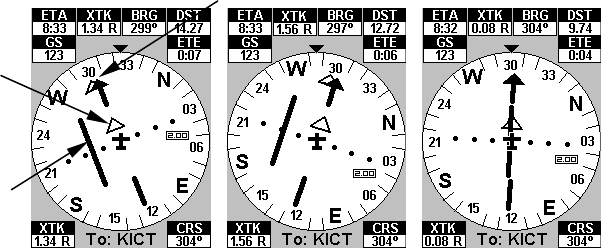
24
The default for the cross track error range is 2.0 nautical miles, which
is shown in a floating text box under the scale. If you veer 2 nautical
miles to the left or right of the course, the off course alarm will appear.
If you are off course to the right, the range box floats to the right of the
course line. If you are off to the left, the range box appears to the left of
the course arrow. You can use the
ZIN or ZOUT keys to change the cross
track error range.
Following a course by "chasing the needle." Fig. 1, plane has veered off course to
the right by 1.34 nautical miles, away from the needle. Fig. 2, pilot turns on
heading of 297º, steering left toward CDI needle to intersect intended course.
Fig. 3, pilot has intercepted his route and is virtually on course.
The most important graphic element, however, is the CDI needle. The
CDI and the cross track error scale instantly show you the distance to
the course line, as well as the direction to steer to get back on course. In
the example above, fig. 1 shows the pilot off course to the right, so the
CDI needle appears to the left of the plane symbol. Fig. 3 shows the
pilot back on course, so the CDI needle appears to line up with the
course arrow. If you steer toward the CDI needle line, you'll always be
heading in the correct direction to get back on course.
NOTE:
The examples above all show navigation to a waypoint, the most com-
mon method of GPS navigation. To show navigation from a waypoint,
see the instructions on the OBS Hold feature later in this section.
The HSI Navigation Page has its own menu, which is used for some
advanced functions and for setting various options. (Options and setup
are discussed in Sec. 5.) To access the HSI Page Menu: from the HSI
Page, press
MENU.
TO
arrow
CDI
ne
e
dle
Fig. 1
Fig. 2 Fig. 3
Course
arrow


















